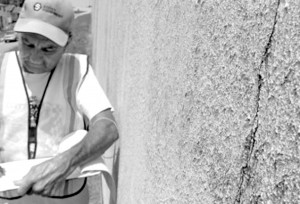Post-Katrina reforms make levee, floodwall inspections a daily job
17th August 2015 · 0 Comments
By Bob Marshall
The Lens
i need some extra cash fast
The heat reflecting off the concrete floodwall along Orleans Canal one July morning made the heat index of 109 seem like a joke, but a three-man team inspecting the walls kept walking, probing and taking notes.
There was no time to stop; they still had 39 miles of floodwalls, 117 miles of levees, 204 floodgates and 102 flood valves to check in Orleans Parish — a routine they repeat four times a year. Meanwhile, another team of eight employees was opening and closing hundreds of gates and valves, which it does every day.

Even small, non-threatening imperfections like this hairline crack in the
surface cement of the Orleans Outfall Canal floodwall are noted in the regular inspection reports now mandatory in Louisiana.
Nonstop inspections are one of the lessons learned from Hurricane Katrina.
Within weeks, investigators began 31903 cash advance compiling a shocking list of mistakes, oversights and wrongdoings that surrounded the collapse of federal levees that crippled the city and led to 1,400 deaths.
One finding surprised no one: Local levee boards, made up of political appointees, had largely ignored federal requirements to inspect the city’s defenses regularly.
Every year, the U.S. Army Corps of Engineers and the local boards were supposed to conduct a joint inspection of more than 100 miles of levees. It typically lasted only about five hours before they adjourned for lunch.
Although some researchers have said the local boards weren’t responsible for the engineering mistakes behind the levee failures, they say the lack of rigorous inspections may well have missed signs the system was in trouble.
For years, residents who lived where the 17th Street Canal floodwalls breached had reported that their yards occasionally became soggy. The water was seeping from the canal under the floodwall. The problem was never spotted by the local levee board or reported to the corps.
“Absolutely, better inspections might have found signs of trouble,” said Paul Kemp, payday loans blacksburg sc a Louisiana State University geologist, member of the local flood authority board and co-author of the report clearing local levee boards of causing the engineering failures.
“There’s no question what we’re doing today is night and day from the old system,” he said.
But Kemp and other board members see holes even in the more rigorous regimen.
The New System
Inspection policies were included in a host of reforms in levee management after Katrina. The local levee boards, which had no professional requirements, were replaced by a regional authority whose governing board must include members with technical and scientific backgrounds.
The east bank levee authority oversees the Orleans, East Jefferson and Lake Borgne (for St. Bernard Parish) levee districts. The west bank authority manages the West Jefferson and Algiers Levee Districts.
Changes in inspection routines came quickly.
In 2006 the state Department of Transportation and Development created its first quarterly inspection program. It requires inspectors to use uniform checklists and record their findings on spreadsheets. Each levee district must summarize its findings and send them to the personal loan pre approval process corps and the state.
“There were some inspections being done before that, but no documentation of the results was ever compiled,” said Bob Turner, the engineer overseeing the east bank levee authority.
In 2008, the newly created state Coastal Protection and Restoration Authority required inspectors to pass a one-day training program.
Turner said his agency has begun developing its own mandatory training program that will include an apprentice period.
The levee districts on the east bank urge all employees to become certified inspectors, Turner said.
“The idea is to have as many eyes on the system as possible,” he said. “If they know what to look for, anyone can spot a potential problem.”
Inspections now take up most of the east bank authority’s $24 million annual budget for operation and maintenance, he said.
The New Routine
Every three months Holzenthal and his team inspect every foot of levees and floodwalls, on each side. They walk the protected side and use boats for the side facing water.
Although they note superficial changes such as hairline cash advance calling cards fractures, their big concern is settling, sloughing or collapsing of soils, growth of trees and other unwanted vegetation, illegal buildings, and the health of the grass.
They also inspect floodgates, drainage gates, bridges and navigation locks.
Thirteen miles of Mississippi River levees are included in the inspection. They’re part of the hurricane defense system because storm surge can cause the river to jump 10 feet in New Orleans.
Those quarterly inspections typically take a three-person crew about six weeks to complete.
“It’s pretty much nonstop,” Holzenthal said. “By the time we finish one round, it’s almost time to start the next.”
Every six months, Turner must send the corps and the state a report describing inspectors’ findings, the steps taken to address any problems, and the maintenance for all the mechanical and electrical equipment.
This includes records showing mechanical systems have been “exercised” – actually operated – at least once a year.
The east bank authority exercises parts of the system daily. Reports are compiled every month and weekly during hurricane season.
“If you wait until guaranteed loans for poor credit history a storm event to find out something isn’t working properly, then it’s too late,” Turner said.
Every three to five years, depending on funding, the Corps of Engineers conducts its own in-depth examination of floodgates and floodwalls, Turner said.
Federal regulations also require inspections after each “storm event,” which Turner said is any time surge pushes water against the system’s perimeter.
Things are far less complicated outside the Orleans Levee District because there are fewer miles of levees. Officials in other levee districts said employees work levee inspections into their other responsibilities.
John Monzon, the regional supervisor of the west bank authority, is an engineer who helped develop the statewide inspection system. He said a private engineering firm handles inspections of the west bank’s large flood and navigation gates.
No Eyes Below The Surface
All of those inspections are limited to the surface. Neither the local levee authorities nor the corps examines the soil and pilings underneath unless there’s a sign of trouble on the surface.
That troubles Kemp. He said there’s often no outward sign do you need a loan of serious problems in the soil or structures supporting a surge protection system.
“The first time we might know about a problem is when the system is stressed during a storm, and we have a failure,” he said.
The regional authority is working with the state to develop a system that will provide real-time assessments of subsurface stability, Kemp said. This will include ground-penetrating radar and sensors embedded to detect movement of walls and soil.
In addition to inspecting and maintaining the levee system, the agencies will have to keep abreast of advancements in engineering and the science of hurricane impacts.
“In a very real sense, we will never have to stop improving this system,” Kemp said. “It won’t do us much good if we have a perfectly maintained system that does not keep up with the level of the threat.”
This story was originally published by The Lens (thelens-nola.org), an independent, non-profit newsroom serving New Orleans. The Louisiana Weekly enjoys a partnership with The Lens.
This article originally published in the August 17, 2015 print edition of The Louisiana Weekly newspaper.



